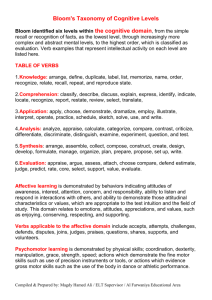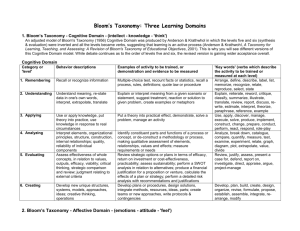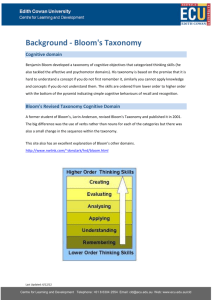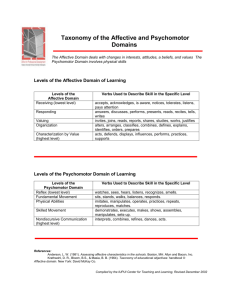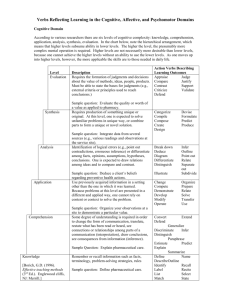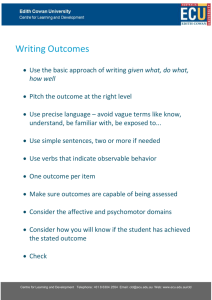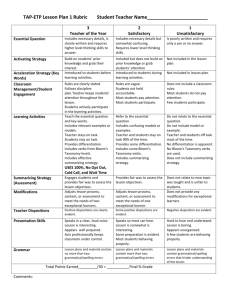Short Introduction to Learning Outcomes
advertisement
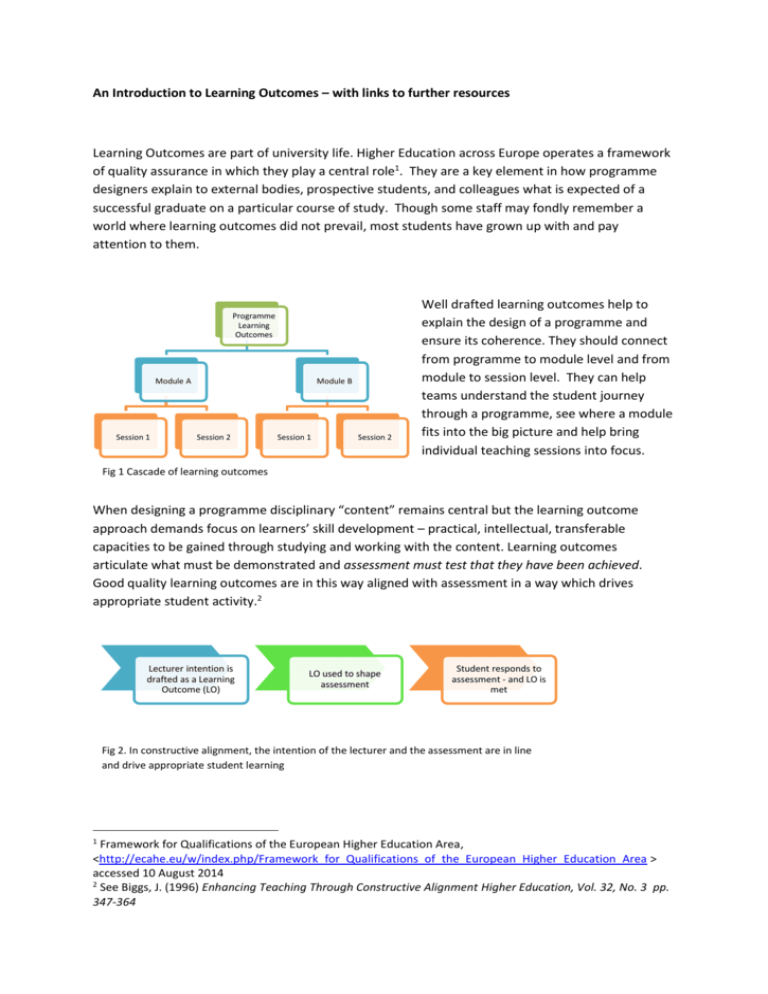
An Introduction to Learning Outcomes – with links to further resources Learning Outcomes are part of university life. Higher Education across Europe operates a framework of quality assurance in which they play a central role1. They are a key element in how programme designers explain to external bodies, prospective students, and colleagues what is expected of a successful graduate on a particular course of study. Though some staff may fondly remember a world where learning outcomes did not prevail, most students have grown up with and pay attention to them. Programme Learning Outcomes Module A Session 1 Module B Session 2 Session 1 Session 2 Well drafted learning outcomes help to explain the design of a programme and ensure its coherence. They should connect from programme to module level and from module to session level. They can help teams understand the student journey through a programme, see where a module fits into the big picture and help bring individual teaching sessions into focus. Fig 1 Cascade of learning outcomes When designing a programme disciplinary “content” remains central but the learning outcome approach demands focus on learners’ skill development – practical, intellectual, transferable capacities to be gained through studying and working with the content. Learning outcomes articulate what must be demonstrated and assessment must test that they have been achieved. Good quality learning outcomes are in this way aligned with assessment in a way which drives appropriate student activity.2 Lecturer intention is drafted as a Learning Outcome (LO) LO used to shape assessment Student responds to assessment - and LO is met Fig 2. In constructive alignment, the intention of the lecturer and the assessment are in line and drive appropriate student learning 1 Framework for Qualifications of the European Higher Education Area, <http://ecahe.eu/w/index.php/Framework_for_Qualifications_of_the_European_Higher_Education_Area > accessed 10 August 2014 2 See Biggs, J. (1996) Enhancing Teaching Through Constructive Alignment Higher Education, Vol. 32, No. 3 pp. 347-364 Designing a programme of study involves multiple stakeholders and is a complex and creative process. Writing programme learning outcomes is central to programme design and they must be articulated in terms of knowledge and understanding, intellectual, practical and transferable skills. They form a key dimension of the Programme Specification which is effectively the contract between the university and its students. The programme outcomes describe the threshold level of achievement for a graduate of a programme of study. Fig3 Key stakeholders in programme design Many factors influence these stakeholders, for example, quality assurance requirements, university strategy, available resources, internal processes and the values and ethos of each discipline and school. This complex range of factors must be considered in writing programme outcomes. Links to further information: QAA UH Strategy CAQA FHEQ Fig4 What shapes programme learning outcomes? Outcomes must be appropriate for the level of study. At programme level this means consulting the Framework for Higher Education Qualifications. At module level the SEEC credit level descriptors are designed to be helpful. Various taxonomies of learning can help articulate progress through a programme; Bloom’s cognitive domain (fig5) is one of the best known. It’s worth recognising when drafting learning outcomes at the appropriate level that material studied varies widely in its complexity – and comprehension of inherently difficult concepts will demand high order thinking just as much as evaluation and synthesis of simpler ones. Fig 5 Bloom’s 1956 taxonomy Biggs (fig6) Structure of Observed Learning Outcomes may also be useful in articulating appropriate learning outcomes . prestructural Unistructural multistructural relational extended abstract Fig 6 Biggs’ SOLO taxonomy – development of learning illustrated with Lego bricks Many resources link Bloom’s taxonomy to appropriate verbs for the level of activity described. Consideration of these can be a useful way to inspire aligned methods of assessment. For example: Teach Thought – 249 verbs for critical thinking Bloom identified two other learning domains: the affective and psychomotor. The affective domain concerns attitudes, emotions, feelings and values; the psychomotor domain, the development of physical skills. These hierarchies may be helpful in drafting learning outcomes for practical and transferable skills. When drafting module learning outcomes it is important to make them specific and demonstrable as they must be assessed. A key feature of successful drafting at this level is to use an action verb. Verbs for the affective domain. Verbs for the psychomotor domain Lee University – collection of action verbs for transferable skills Writing effective learning outcomes is an art which demands negotiation and creativity. Learning in fact is much more integrated than these distinct domains would suggest and it is important to draft something which is engaging and comprehensible. There are no hard and fast rules. Aims and Learning Outcomes Aims must relate to learning outcomes but are directed more at the teaching and management of learning – and broadly indicate what it is planned to cover in any given period of study. They can be broader aspirational statements which are more loosely drafted as they are not assessed – though it is expected that successful students would typically achieve them. Where to find more information Templates and more advice from UH Centre for Academic Quality Assurance South East Education Consortium How to Use Learning Outcomes & Assessment Criteria Learning and Teaching Support Network Guide for Busy Academics (Learning Outcomes) Learning and Teaching Support Network Guide for Busy Academics (Constructive Alignment) ABCDs of Writing Instructional Objectives – with lists of action verbs for each Bloom domain Fry, H. , Ketteridge,S. & Marshall, S. (2008) A handbook for teaching and learning in higher education Routledge Ltd (available as an ebook through Voyager) Moon,J. (2002) The Module and Programme Development handbook Kogan Page Examples of programme learning outcomes can be found in UH programme specifications via a simple web search. But beware simple cut and paste – do the LOs really address what you wish to address? Module learning outcomes are in Definitive Module Documents (these should be available through a module’s Studynet site under Module Information).

